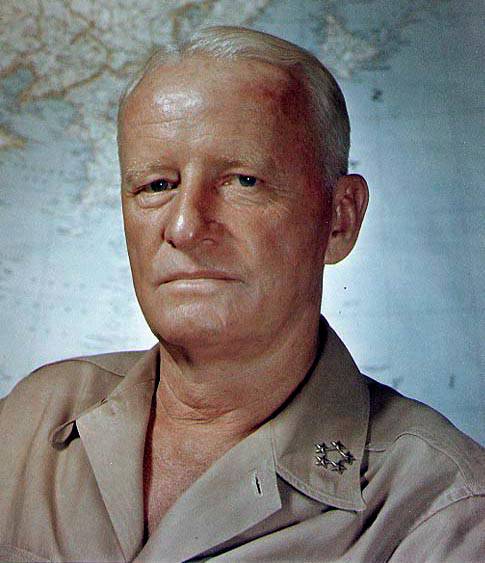
FAQ About Chester Nimitz

Who was Chester W. Nimitz?
Chester W. Nimitz was a Fleet Admiral in the United States Navy who played a pivotal role during World War II, particularly in the Pacific Theater. He was the Commander in Chief of the U.S. Pacific Fleet and later commanded all Allied air, land, and sea forces in the Pacific Ocean areas. Nimitz was instrumental in multiple campaigns and battles against Japanese forces, significantly contributing to the eventual Allied victory in the Pacific.

What were some of Chester Nimitz's most significant contributions during World War II?
Chester Nimitz's significant contributions during World War II include his strategic leadership in the Battle of Midway, which is considered a turning point in the Pacific War. His ability to effectively utilize intelligence and coordinate complex naval operations helped in orchestrating successful island-hopping campaigns and amphibious assaults across the Pacific. Nimitz's guidance was critical in major operations including the capture of the Solomon Islands, the Mariana Islands, and the Battle of the Philippine Sea.

When did Chester Nimitz serve as Fleet Admiral?
Chester Nimitz was promoted to the rank of Fleet Admiral of the United States Navy on December 19, 1944. This rank is the highest possible in the U.S. Navy and was created to provide equivalent ranks among the top military services during World War II. Nimitz served in this capacity until his retirement in 1947, although the rank of Fleet Admiral is a lifetime appointment.

Where was Chester Nimitz born?
Chester W. Nimitz was born in Fredericksburg, Texas, on February 24, 1885. His birthplace in the Texas Hill Country reflects his German-American heritage, with his grandfather having immigrated from Germany to the United States.

What is the significance of the Battle of Midway involving Chester Nimitz?
The Battle of Midway, which occurred in June 1942, was one of Chester Nimitz's most significant triumphs. It marked a crucial turning point in the Pacific War, significantly weakening the Japanese Navy's offensive capability. Nimitz's leadership and strategic use of intelligence allowed the U.S. Navy to deliver a crushing blow to the Japanese fleet, sinking four of its aircraft carriers and shifting the momentum in favor of the Allies in the Pacific.

How did Chester Nimitz impact post-war Japan?
After World War II, Chester Nimitz's role shifted to overseeing the post-war demobilization and restructuring of the U.S. Pacific Fleet. While Nimitz himself was not directly involved in the occupation of Japan, his strategies during the war laid the groundwork for the post-war balance of naval power in the Pacific. Nimitz also supported initiatives focused on rebuilding and stabilizing Japan as a peaceful nation, which was crucial during the early period of U.S. occupation.

What awards and honors did Chester Nimitz receive?
Chester Nimitz received numerous awards and honors throughout his illustrious career, including the Navy Distinguished Service Medal, the Army Distinguished Service Medal, and the Silver Lifesaving Medal. In recognition of his leadership, strategy, and service, Nimitz was also honored with foreign decorations, such as the Grand Cross of the Order of the Bath by the United Kingdom and the Legion of Merit from Brazil. He remains a respected figure in naval history.

Did Chester Nimitz write any books or memoirs?
Chester Nimitz did not write any traditional memoirs, but his career and experiences have been well-documented in various biographies and military analyses. "The World War II Memoirs of Admiral Chester W. Nimitz" by E. B. Potter and Jürgen Rohwer offers insights into his wartime strategies and leadership. Additionally, his legacy and impact have been studied extensively in historical and military publications.

What was Chester Nimitz's role in the Pacific Fleet's island-hopping strategy?
As Commander in Chief of the U.S. Pacific Fleet, Chester Nimitz played a key role in implementing the island-hopping strategy during World War II. This strategy involved selectively attacking specific enemy-held islands and bypassing others to progressively move closer to Japan. Nimitz's leadership ensured effective coordination between naval, air, and land forces, leading to successful campaigns such as those in the Solomon Islands, the Marianas, and towards the ultimate goal of invading Japan.

What role did Chester Nimitz play in the signing of Japan's surrender?
Chester Nimitz played a significant role in the preparations and execution of Japan's surrender ceremony. As the representative of the United States, he signed the Japanese Instrument of Surrender aboard the USS Missouri on September 2, 1945. This event marked the conclusion of World War II and underscored Nimitz's pivotal contributions to the Allied victory in the Pacific.

Where is Chester Nimitz buried?
Chester W. Nimitz is buried at the Golden Gate National Cemetery in San Bruno, California. His grave is located in Section C, Site 1, among other notable military figures. The cemetery serves as a resting place for many veterans and their families, honoring their service to the United States.

How did Chester Nimitz's early career prepare him for leadership during World War II?
Chester Nimitz's early career included diverse experiences that honed his leadership skills, such as serving on various ships and submarines, teaching naval tactics, and engaging in logistics. His tenure on destroyers and submarines cultivated a deep understanding of naval operations. Furthermore, his positions in the bureau of navigation and as Chief of the Bureau of Navigation helped him develop an administrative acumen that was invaluable during World War II.

What was Chester Nimitz's relationship with other Allied leaders during World War II?
Chester Nimitz maintained strong, cooperative relationships with other Allied leaders during World War II. His collaboration with General Douglas MacArthur and Admiral William Halsey was critical in synchronizing naval and ground operations in the Pacific. Nimitz's diplomatic skills and focus on unified goals helped foster trust and effective partnerships, significantly contributing to the success of the Allied forces.

What were Chester Nimitz's views on peace and reconciliation after World War II?
Chester Nimitz was a proponent of peace and reconciliation following World War II. He believed in fostering positive international relations and advocated for rebuilding efforts that would promote stability and cooperation among former adversaries. Nimitz's forward-thinking approach sought to heal wartime wounds and prevent future conflicts through diplomacy and mutual respect.

How is Chester Nimitz remembered today?
Chester Nimitz is remembered as one of the most influential naval officers in American history. His legacy is honored through various monuments, schools, and institutions bearing his name, such as the USS Nimitz, a nuclear-powered aircraft carrier. Additionally, his strategic innovations and leadership during World War II continue to be studied in military academies and by historians worldwide.

Did Chester Nimitz have any notable protégés?
Chester Nimitz mentored several notable naval officers who went on to have distinguished careers, including Admiral Raymond A. Spruance and Admiral Marc A. Mitscher. These officers absorbed Nimitz's strategic wisdom and leadership qualities, which helped them execute successful operations during and after World War II. Nimitz's influence extended beyond his direct subordinates, affecting broader naval strategies and doctrines.
